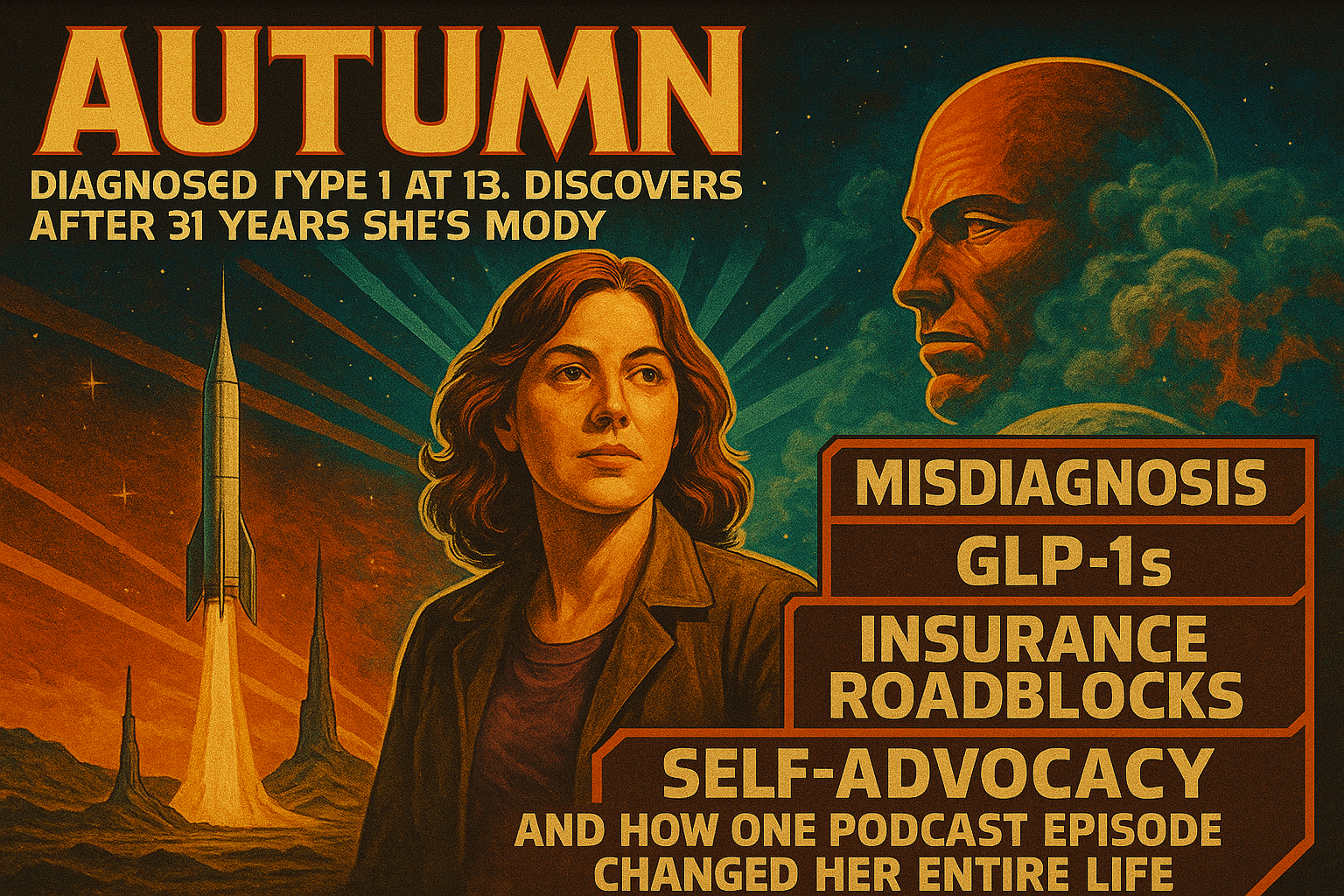#1651 CGM Graph Reading
You can always listen to the Juicebox Podcast here but the cool kids use: Apple Podcasts/iOS - Spotify - Amazon Music - Google Play/Android - iHeart Radio - Radio Public, Amazon Alexa or wherever they get audio.
Scott and Jenny name and define the blood sugar “shapes” seen on CGM graphs—bell curves, spikes, plateaus, roller coasters—to create a shared language for understanding glucose patterns.
+ Click for EPISODE TRANSCRIPT
DISCLAIMER: This text is the output of AI based transcribing from an audio recording. Although the transcription is largely accurate, in some cases it is incomplete or inaccurate due to inaudible passages or transcription errors and should not be treated as an authoritative record. Nothing that you read here constitutes advice medical or otherwise. Always consult with a healthcare professional before making changes to a healthcare plan.
Scott Benner 0:00
Hello friends and welcome back to another episode of The Juicebox podcast.
On today's episode, Jenny and I are going to try to give names to the shapes that you see on your graph. So when you're looking at your CGM, and you start low and it goes up high really quickly and comes back down. What do we call that? Is it a spike? Is it a peak? And what about the graphs that look like roller coaster tracks, or how about those quick drops that come back up again? We're going to try to define them, to give them names, so that we can talk about them on the podcast, so that we can take your graphs and try to figure them out on an audio show in a way that will allow you to follow along. Let's see if we can do it. Please don't forget that nothing you hear on the Juicebox podcast should be considered advice medical or otherwise, always consult a physician before making any changes to your health care plan or becoming bold with insulin. This episode of The Juicebox podcast is sponsored by Medtronic diabetes and their mini med 780 G system designed to help ease the burden of diabetes management, imagine fewer worries about missed boluses or miscalculated carbs thanks to meal detection technology and automatic correction doses, learn more and get started today at Medtronic diabetes.com/juicebox this episode of The Juicebox podcast is sponsored by the contour next gen blood glucose meter. Learn more and get started today at contour next.com/juicebox text.com/juicebox, Jenny, we're going to try something today. Yay. I do not know if we're going to be successful. Okay, well, no, it was a new, new idea. It's a completely new idea, yay. I don't know how successful we're going to be, but I'd like to try to quantify the different graphs on a CGM with words and give them names so that we can later make episodes where we talk about graphs in a way that people who don't have a visual can follow along with, okay? So we have to identify the shapes the pathway of the dots on on a CGM and then give them a fun name that people can remember. Oh, okay, all right,
Jennifer Smith, CDE 2:24
well, I can, I mean, I can think of one like, we're talking about graphs, and I've used it a million times before, right when you're eating real food or a mix of foods that contain carbohydrates, and we've talked about it in terms of insulin timing and what things should look like on a graph. It should look somewhat like a bell curve. If people are familiar with that term, right time your insulin right blood sugar should go up some. You might have a target range you want to stick with, but that up should plateau, and then it should nicely curve back down, so that by the time the Bolus is done working and your basal is well set, it lands you, and you stay stable. Okay, that's one I can think
Scott Benner 3:02
of. That's awesome. So I'm putting bell curve here on my list. I have an extensive list here. Oh, so there's 20 of them, and I don't think, oh, sorry, I didn't mute my phone. Okay, somebody's alarming for some reason. Martin's over 130 if that's beeping, yep. Okay, so bell curve, and we're going to get, we'll get a little description for so we have that on the list. So here's an easy one, like a flat and stable line that's in range, right? So a flat line that's going on forever, we need to know how to talk about it. So I think that one we can just call flat line, right?
Jennifer Smith, CDE 3:36
Call it the state of Ohio, no, because it's flat.
Scott Benner 3:39
I don't know if people outside of the Midwest are going to understand that or not. Understand that or not. Flat, so steady and in range with no real deviation. We'll call that a flat line. Yes, fair. Okay, fair. So now a post meal spike, a sharp rise after eating that will end with a sharp drop.
Jennifer Smith, CDE 3:59
Okay, so it's almost like a mountain, yeah, it would be like a mountain peak, almost, because some mountain ranges just go up and kind of stay up. This is really a mountain peak.
Scott Benner 4:10
Okay, so we're gonna call a post meal spike that drops back down again a mountain peak, all right? So we have a flat line, we have a bell curve, so we'll call it a bell right? We have a mountain peak now a rise that dips down from insulin and then rises back up against from fat and protein.
Jennifer Smith, CDE 4:32
So it rises up. First it comes down, goes and then it goes back
Scott Benner 4:36
up, camel, back just camel. Maybe that
Jennifer Smith, CDE 4:39
really depends on what kind of Camel you're talking about. Did you know that there are two kinds of camels? There's the one hump, which is a dromedary. Go ahead, and the other hump, I can't remember the name of it, but it looks like if you turn a B on its side, it's too humped. And there is a name for that type of Camel too. So one hump is a dromedary and the other one is B, something or. This at our zoo. I should know this, because my boys read it every time that I go to the zoo.
Scott Benner 5:04
Wait, okay, two humped what's the camel called?
Jennifer Smith, CDE 5:09
What is a two humped camel called Bactrian I knew I would remember it. Bastrian. Yeah, B, A, C, T, R, I, a, n. Bactrian camel camel.
Scott Benner 5:23
There you go. Okay, well, we can't call it backtree in because nobody's gonna know what that means. So we're gonna call it a to come to hump. You get married and you have a two hump year, there you go. To hump. Camel. Okay, roller coaster, big swings up and down, like from chasing, yeah, right, yeah. But does roller coaster indicate to you sharp ups and downs or up down, up down more?
Jennifer Smith, CDE 5:56
It could be, honestly, either it could be, gosh, I see the mountain peak coming, so I'm going to get ahead of it staying high. So now I really try to crush it, and it's way too much. And now I come way down and oh, gosh, I'm going to crash. And now I treat it and way it goes way back up. That could be a little bit more pointy, whereas something that is a little bit of a smoother roller coaster might be a different type of meal or, you know, whatever. So it could be either
Scott Benner 6:29
we could use roller coaster as a as a general. But then when we talk about it, talk about it more like a peak or a gradual roller coaster, like either like a sharp up, sharp down, or gradual up, gradual down, one way or the other, up, down, up, down, up, down. Forever. Is a roller coaster. I think of it as Jake. You're chasing the blood sugar.
Jennifer Smith, CDE 6:49
It is and in two situations, in the daytime, chasing blood sugar because of variables. In the nighttime, if it's up, down, up, down, something's wrong with your settings,
Scott Benner 6:59
Okay, what about the one that kind of goes up? Stops, goes up again. Stops, keeps, like, it kind of like staircases and that, and you can see them go down to, like, what scenario,
Jennifer Smith, CDE 7:10
almost like a pyramid, yeah, exactly like you're building a level on it, building a level
Scott Benner 7:16
up. Yeah. Is that from, I guess? What could that could be? A lot of things. It could be, could be bad basal. It could be an infusion site that's not right, right? It could be a little bit of a fat, you know, I've seen it sometimes with algorithms, you go up and you hit that kind of like you've missed it, and it Bolus is a little and you come down a little bit, and then it brings you back up again. It's almost like up, like an Up Down Staircase. So there's a couple, all right, so there's six.
Jennifer Smith, CDE 7:45
It's not a roller coaster. It is a continual climb that might have little plateaus.
Scott Benner 7:52
It's the algorithm. Like, you go up, the algorithm thinks insulin, but it's never going to give you enough. And so then you get a little stability for a while. Don't really go down, and then it goes up again, so the more like staircasing up, and it can happen in the down, too.
Jennifer Smith, CDE 8:06
And it might be around foods that do have, they might have a fair carb content to them, but they also might have a really good fat content, and so you may not have timed well enough to stop that initial rise up, and then as the insulin does get working along with the food, the fat, at times, is actually slowing down, what would otherwise be a pretty rapid rise, like the mountain peak effect, right where you're just going to keep going up, whereas with fat included, you're going to get a little bit of an inching, inching, And eventually that might, even if you don't know well enough to cover proteins or fats, you might actually get that inch up, and then it just plateaus at the top. Yeah.
Scott Benner 8:49
Have you ever seen somebody do a cat ears on their Dexcom? They get a meal spike and a quick drop, but it doesn't go all the way back down. Then it sits a little stable higher, and then it happens again, like a quick spike, and then they really crush it the second time, and it drop. And then they'll drop like a they'll draw cat eyes on it, or whiskers, or something like that. Yeah, so we'll call that one. What do we call that one? Cat eyes? No, cat head, no. We can't call it cat head.
Jennifer Smith, CDE 9:20
Call it, I don't know, just cat.
Scott Benner 9:24
All right, for now, we'll call it cat. You know, it just occurred to me, as I thought of that, to google it, and now I'm thinking we should probably just Google that with,
Jennifer Smith, CDE 9:33
like, maybe chat DPT could come up with a fancy name for all
Scott Benner 9:37
we're gonna have to come up with something here. All right, so then there's the dawn phenomenon, kind of curve, right? Like you're super flat overnight, and the morning comes, and then you're just on that, like, slow, steady climb that goes forever. I think of that one as the price is right. Game, the mountain climber.
Jennifer Smith, CDE 9:57
Game, oh gosh, I haven't thought about. The Price Is Right and forever.
Scott Benner 10:01
Thank you. I'm gonna call that one climb like we already use mountain peak. No, no one's gonna No one's gonna know.
Jennifer Smith, CDE 10:08
No one's gonna know what that means. Yeah, it's a slow,
Scott Benner 10:13
it's a slow Gray, it's a, it's a, it's a very consistent and steady increase.
Unknown Speaker 10:18
You call it the rock climber.
Scott Benner 10:21
Yeah, that's more up. That's more straight up, though, right when you're climbing, I'm gonna write prices right here so we can figure out something more.
Jennifer Smith, CDE 10:28
It's too bad we couldn't find a one to call Plinko.
Scott Benner 10:32
That was like to watch. There are some that look like that, but maybe we could call it the Bob Barker. Actually, people would kind of funny. Who's the other guy? Drew Carey. Drew Carey Benner, all right, hold on a second. Maybe we'll call that Bob Barker.
Unknown Speaker 10:47
Now, you don't forget to
Scott Benner 10:52
spay or new to your animals. Remember he would do that. Did that 100% that little microphone. He lived a long time, by the way,
Jennifer Smith, CDE 10:59
and he was on that show for a long time, too.
Scott Benner 11:04
All right, so the next one I have here is, like a sharp plunge for hypoglycemia, like it just drops off a cliff, right?
Jennifer Smith, CDE 11:10
That's what I call it, falling off a cliff. You call it cliff diving, okay? Cliff Diving. That's good. All right, that's what I always and I, you know, there are some scenarios that definitely go along with that right? One of that I'm frequently use that term kind of for is when a sensor is being compressed because it looks like the sensor data is just like diving right off of where it was stable before, and it just takes an immediate like plunge. So that's one scenario of something like that, but another one would be obviously way too much insulin for a scenario that wasn't planned for, right?
Scott Benner 11:49
I think of them a little differently, because the compression low, which I think is what you're describing, they look a little different to me, because they're not a consistent fall, like, sometimes, no, they're not a consistent line of dots, yeah. And sometimes you get like, the disappearing, like, the like, it almost goes to, like, it's there, and then it's gone, and when it comes back, it's 15 points lower, right, and then stable again. Like, there's something about the compression low, if you're not actually falling during the low, every time it shows back up, it shows back stable. Does that make sense? Yes, yeah. I mean, I think compression low is just what we'll call that one. Yes. So clip, dive, compressional, no flat, but elevated. So you've woefully missed on a meal, probably right, and your basal is holding you steady, but it's holding you steady way too high, forever, like a plateau, that would be a plateau. Okay. All right, good.
Jennifer Smith, CDE 12:44
Is there a name for those, like in the out in the like the West, you know, where all of the so we're looking for a name for those plateaus that are elevated above the actual ground, almost like a mountain that goes up, but it doesn't have a peak top. It's just flat. I thought there was a name for those,
Scott Benner 13:03
cross your fingers that it's called. Says it's called a plateau. Oh, I said, What is a raised but flat, natural structure called a plateau. Okay? Other natural words sometimes used, depending on nuance, Mesa. Oh, a mesa. That's what you're thinking of, yeah, Butte and table land. Oh, a beaut. Yeah, there's Crested Butte. There's Yeah, but plateau is something. I think that's a word people know, right, yeah, okay, yes. Because now we're doing this for the people listening, because we are, at some point, Jenny and I are going to record short episodes where we take somebody's graph and talk through what we think happened to it, but it's, of course, going to be audio only, and so you need to be able to visualize what the graph looks like. The graph looks like. So that's why she and I are doing this. Now, hopefully you'll find this interesting, and then one day you'll hear a series of like, I don't know. We don't. Haven't figured out what to call that yet, but yeah, maybe graph breakdowns or something like that. Okay, let's see. So plateau and then meal stacking peaks, multiple back to back spikes from closely spaced meal snacks. Today's episode is sponsored by Medtronic diabetes, who is making life with diabetes easier with the mini med 780 G system. The mini med 780 G automated insulin delivery system anticipates, adjusts and corrects every five minutes. Real world results show people achieving up to an 80% time and range with recommended settings, without increasing lows. But of course, Individual results may vary. The 780 G works around the clock, so you can focus on what matters. Have you heard about Medtronic, extended infusion set. It's the first and only infusion set labeled for up to a seven day wear. This feature is repeatedly asked for, and Medtronic has delivered. 97% of people using the 780 G reported that they could manage their diabetes without major disruptions of sleep. They felt more free to eat. What they wanted and they felt less stress with fewer alarms and alerts you can't beat that. Learn more about how you can spend less time and effort managing your diabetes by visiting Medtronic diabetes.com/juicebox the contour next gen blood glucose meter is sponsoring this episode of The Juicebox podcast, and it's entirely possible that it is less expensive in cash than you're paying right now for your meter through your insurance company. That's right. If you go to my link, contour, next.com/juicebox, you're going to find links to Walmart, Amazon, Walgreens, CVS, Rite, aid, Kroger and Meyer, you could be paying more right now through your insurance for your test strips in meter than you would pay through my link for the contour next gen and contour next test strips in cash. What am I saying? My link may be cheaper out of your pocket than you're paying right now, even with your insurance, and I don't know what meter you have right now, I can't say that, but what I can say for sure is that the contour next gen meter is accurate. It is reliable, and it is the meter that we've been using for years. Contour next.com/juicebox and if you already have a contour meter and you're buying test trips doing so through the Juicebox podcast link will help to support the show. So, like, right? Like, the, like, the, we call them,
Jennifer Smith, CDE 16:30
it would be almost like a mountain range, Alpine, yeah, right, because it would almost be like, you've gotten up to the peak of a mountain, but it just stays up there and keeps going up and
Scott Benner 16:40
down. Yeah, it's like a lightning bolt moving up to the right. So there's no backdrop. There's like, Spike, little weight, Spike, little weight, Spike, little weight. So that happens. Can happen if you get behind one meal and then you start eating more and more meals, or another course of something, or something or something like that. Okay, so we can call that that. So what are we gonna call that lightning bolt? But I just think, I think lightning
Jennifer Smith, CDE 17:08
bolt is more of like a, yeah, jagged. I'm look. I'm thinking more of it goes up, and then it's more of like a plateau with peak, peak, peak, peak, kind of along the way. So what did you call it? Something Alpine. There you go,
Scott Benner 17:21
gentle rise or gentle fall across an entire day. I call that a drift, yeah, yeah, okay. Is it a basal drift? Like depends on what you see in the data? Just, yeah, okay. I dropped during activity, and then a delayed spike hours later, that a thing you see a lot. Yes.
Jennifer Smith, CDE 17:44
I mean, there are good reasons for it. Actually just got done talking with somebody about those issues. A name for it, though. So I mean to bring in relevance to description without an actual graph visual for people who are listening, it has to be a name that's centered around exercise,
Scott Benner 18:08
right activity, drop
Jennifer Smith, CDE 18:11
didn't plan well,
Scott Benner 18:16
I just interviewed a woman earlier today that you know when she was first diagnosed, somebody told her, like you need to when you go to have a baby one day, I need you to plan a year in advance, and then when years later, when she would have a baby. She followed those instructions. She started planning a year before she had her baby. Could for her. She said that a combination of your book and my episodes about pregnancy, she had a very smooth pregnancy. That's awesome. Yay. She planned ahead. And it made me think of that when you said didn't plan, I don't think we can call it activity drop. No, you stop.
Unknown Speaker 18:52
Totally kidding.
Scott Benner 18:55
Something about activity exercise that's going to take some you know what we're going to do. We're going to take this list, and I'm going to take it online, and I am going to get people, yeah, I'm going to get feedback, because there's probably a thing people colloquially call this stuff, right? So that could be, all right, predictable spike linked to menstrual cycle, puberty, stress, or cortisol, so hormonal, I don't know. That's still just a spike, right? Does that look
Jennifer Smith, CDE 19:21
it is. But if we have some data that we're talking about and we know it's relative to a hormonal change, it may make sense to call it hormones,
Scott Benner 19:33
okay, all right. Do you think it's a thing we'll see on a graph at some point? I mean, somebody's gonna say to me, this is my period, right? And we're gonna have to talk about it, yeah. So, okay, all right. So why don't we call it a hormonal surge? There you go. Great. I like the way, the way surge sounds there, compression, low. We went over already, a late night spike, so hours after a meal. I mean, you know, we're talking about like, you know, a pizza you ate at 1030 or something. Like that, then you get that that kind of like, See,
Jennifer Smith, CDE 20:03
I prefer to call it restaurant.
Scott Benner 20:07
Restaurant hit it's a fat rise in my
Jennifer Smith, CDE 20:09
mind. Oftentimes it is if, again, we're basing this on all other things are tested and true, right? And if they aren't, then go back to the drawing board, and don't use this until you have settings that are pretty good. But for something like this, that's why I said restaurant, because it's often a fat hit that's very late.
Scott Benner 20:32
There's another one that the shape of it looks like a shark fin. So it's sort of like a like a quick spike and then a slow drift, right? So you get the, I'm holding my hands up, no one listening, because this is going to be the problem. So you get that, that quick spike, but then it's more of an a frame, like drift away. So that shark fin, that one will be an easy one. Yeah, the zigzag. Have you ever seen a zigzag, just like sawtooth? It just keeps going like that forever and ever, all day long, kind of like the roller coaster? Yeah, I guess so, right, zigzag roller coaster. All right, they're kind of similar. I'm deleting that one. Boom. I'm very easy to get along with that one's gone long stretch, a prolonged plateau. And plateau is a plateau. We don't need that listed twice. What about when two of the shapes come together? Because there's going to be repeatable stuff. I'm making this up. But after we do this for a while, what we're going to see is that people come out of a roller coaster and go into a bell or, like, or, you know, people come out of a bell curve and into a this. Like, we need a word for the transition. What is it going to be called when two graphs are on the same day one turns into the next? Like there's going to be, there's a name for that transition there, the coupling of that's that's harder. Maybe we're gonna have to workshop that. Maybe that'll come up naturally while we're having the conversation.
Jennifer Smith, CDE 21:57
Yeah, okay, I did think of something while you were just talking about that night rise. It could also be relative to kid growth, because it's very common for kiddos who have, especially younger kids who have early enough dinners, they're not eating at eight or nine o'clock at night. For the most part, they're eating a dinner at five maybe six o'clock, and then they end up going to bed, and as soon as they fall asleep, or their head hits the pillow, up, their blood sugar goes so that's definitely different than restaurant effect, but it's an age specific issue,
Scott Benner 22:37
growth hormone. But describe it to me, though, what's it look like?
Jennifer Smith, CDE 22:41
Visually? Visually, it looks like they ate something and didn't Bolus and literally had no insulin for it at all. They have a really nice, smooth post dinner, trucking along really nice and stable into bedtime, and as soon as they fall asleep, up it goes, I see it too in the afternoon, for kiddos who still nap, we often will have some type of a setting that accommodates for an afternoon, two or 3pm snack, because if it's not covered up, their blood sugar goes because they fall asleep,
Scott Benner 23:14
is what usually happens a spike? Is it? Is it drastic? Usually, it's
Jennifer Smith, CDE 23:19
usually drastic in most In fact, it's one of the most frequent things that I hear parents complain about. How do I get over I can do the day, but this end of night thing that happens? Yeah, I feel like I give three times the amount of insulin that I would normally give during the day, and it still is way too
Scott Benner 23:37
high. Oh, uncheck does it go to a plateau at some point,
Jennifer Smith, CDE 23:42
very likely it would go to a plateau at some point. Yes, okay, but today's parents really they don't want that for their child. I wouldn't want that for myself or my child either. And so the plateau is hard to see, unless you really tell somebody, Hey, we have to watch for what is the rise? How can we average the rise? See how much you get before it actually stabilizes too high, and then we can figure out a strategy for bolusing to prevent
Scott Benner 24:11
it. Okay, I have a real feeling about how this is gonna go. Because, okay, yeah, this is starting to make a little sense to me, because using that was an example, like somebody is going to show you that graph, and the person who's showing it to you does not know what's happening, right? And so a person will come online and go, that looks like growth hormone to me, and that'll be the end of it. But as you and I talk through each one of these shapes, because that's going to be the next thing, I'm going to send you all the shapes, and then we're going to talk through the shapes. Fabulous.
Jennifer Smith, CDE 24:38
It'll be fun. Are you going to draw them yourself.
Scott Benner 24:41
Oh, I hadn't thought about that. I'm gonna, I'm hoping people will send me real drafts, yeah, like once we get the My goal here is to get down the the naming structure a little bit and then have a good, solid description of what that structure, the shape is, sure, and then have somebody. Say, Oh, I have one of those. Here it is. And then now you and I have like, actual like models to work with. Awesome. My idea here is to first talk through each shape individually in short episodes. Then after they're out, take people's graphs that they send in and just try to diagnose them without knowing anything about what they did, right? Because I think where did all this come from? This all came from people send me a lot of graphs, but not usually a lot of context, right, right?
Jennifer Smith, CDE 25:37
What do I do here? Look at this graph. You're like, Well, tell me what went into this day, because that would help.
Scott Benner 25:43
And in a perfect scenario, I'd like to know that too. Like, I think that's right. But I think that after years and years of looking at them, you can kind of infer. You can kind of, yeah, I think what happened here might have been this, right? We have this great argument online. I used to have this great argument with this woman in the Facebook group where I would always see a rise and then a plateau. And after hours, the plateau is not touched by the basal at all. There's some people, and then it comes down. Eventually, there was these two arguments that would happen online. Like, one person would be like, That's basal, and the other person would be like, That's Pre-Bolus. And it is, if it is and it isn't, anyway it's, there's like, this nuance there that I think is going to be interesting to talk through on all of these. So anyway, so we're going to, we're going to get the naming together, then we're going to break down what that you know, what that naming exactly means. We'll get examples of them you, and I will record a short episode describing each shape. And then we'll let people send in graphs that are like 12 hour, six hour, 24 hour graphs. And then we can describe you as we're going, here's a 12 hour graph. It's a plateau that goes into a this, that goes into that. And then we'll talk through how we think it happened. Yeah, all right, that'd be great. And then we'll start getting people who have the graphs with the information about the food. Then we can blind, break them down, and then layer over the information they said, to see if we were right or wrong about what they did and where things happened. Sure. This is genius. Jenny, yay. Yes. This is gonna be real. Listen to me. This is not
Jennifer Smith, CDE 27:21
like, do you want to just step in and, like, record all of my conversations with people all day long. Because this is, this is what I do.
Scott Benner 27:27
Yeah, I know. I just, I thought, to turn into a pocket No, no, fantastic.
Jennifer Smith, CDE 27:32
I well, I think, because it'll take very consistent scenarios that people see over and over and apply a an idea for how to work
Scott Benner 27:44
it out. I think so too. I have been blocked, mentally blocked, on this for years. This is obviously something that I've been thinking about for a long time and but I kept just saying, like, well, it's not a video podcast. Like, if you can't see it, then what's the point? Like, you're never going to know. But I don't think maybe that's true. I think maybe there's a way to talk through it and describe it, describe it, and then, you know, I have a website. I could say, like, look for this episode. The graphs on the episode. You can listen to it while you're staring at it, if you want to, and if you don't want to. You know, again, I think the repetition of us talking about it, what am I talking about here on a series I'm talking about, maybe by the time it's over. I don't know, 40 short episodes like spread out over a year. You listen to those for a year, you're probably you'll know what you're doing by the time it's over, right? Yeah, that's all, dammit. Yay, yay, yay, yay. Good. I good idea was not all my idea is the thing that people have been foisting on me for a long time. I have thought it was a good idea. I did struggle with how it would work. Audio Only, and then full respect to Steven, who was on an episode recently, and just said, like, why don't you just give all the shapes names? And I was like, Oh, well, that makes sense. We're gonna have to break down. I assume we're gonna be using the same, probably less than 10 shapes, mostly when we're talking about
Jennifer Smith, CDE 29:03
stuff. Well, I think also a lot of the other episodes that we've done together are a very good starting place for now understanding how to see the shapes. We have lots about nutrition. We have lots about the effect of different foods, and lots about insulin use and how to time things, right? So this will now make a lot of sense if you've listened to those episodes as well. Yeah, I think you can kind of bring it all together.
Scott Benner 29:33
This is all going to culminate in the next couple of years with you. By the way, you have to continue to do this with me, or you're stuck. You have to do this. I'm stuck. To me. This culminates with us re recording a Pro Tip series as if we've never done it before, because I believe that who I am and who you are has been informed a lot by all the conversations that we've had and all the time and. Experiences we've had since then. I'm interested to see what another recording of the same topics would sound like. I think it's possible it would, I don't know well, and
Jennifer Smith, CDE 30:09
how many years has it been since we did that? Because technology has also changed considerably.
Scott Benner 30:17
I was thinking about this today. Actually, technology's changed. A ID systems are here, but in the end, whether you're on an A ID system or you're not, the basis of what that Pro Tip series is about, still maintain it sticks right. It's about timing, it's about amount, it's about using insulin in the right places. It's about your settings. Yeah, it's almost turns the A ID system into another variable, because still, in the end, your understanding of how insulin works, it's the foundation. It's the foundation of the entire thing. Almost said plateau, because now I've said it 17 times today, a word I have not said in years. I think that you and I might be able to put together like a pan ultimate kind of conversation that would going to end up encapsulating all the stuff you just talked about, because nutrition, they might be a little longer, but listen. What are you guys busy with? Just listen to the podcast. It's free. You know what I
Jennifer Smith, CDE 31:18
mean? Weed your garden and put the earbuds in.
Scott Benner 31:20
You know you're all not gonna hire Jenny and I can't come to your house, so like you have to figure this out on your own. Thank you very much. I appreciate, of course,
Jennifer Smith, CDE 31:28
no, it's great. Thank you.
Scott Benner 31:37
I'd like to thank the blood glucose meter that my daughter carries the contour next gen blood glucose meter. Learn more and get started today at contour next.com/juicebox and don't forget, you may be paying more through your insurance right now for the meter you have than you would pay for the contour next gen in cash. There are links in the show notes of the audio app you're listening in right now, and links at Juicebox podcast.com to contour and all of the sponsors, thanks for tuning in today, and thanks to Medtronic diabetes for sponsoring this episode. We've been talking about medtronics, mini med 780, G system today, an automated insulin delivery system that helps make diabetes management easier day and night, whether it's their meal detection technology or the Medtronic extended infusion set, it all comes together to simplify life with diabetes. Go find out more at my link, Medtronic diabetes.com/juicebox
Hey, thanks for listening all the way to the end. I really appreciate your loyalty and listenership. Thank you so much for listening. I'll be back very soon with another episode of The Juicebox podcast. My diabetes Pro Tip series is about cutting through the clutter of diabetes management to give you the straightforward, practical insights that truly make a difference. This series is all about mastering the fundamentals, whether it's the basics of insulin dosing adjustments or everyday management strategies that will empower you to take control. I'm joined by Jenny Smith, who is a diabetes educator with over 35 years of personal experience, and we break down complex concepts into simple, actionable tips. The Diabetes Pro Tip series runs between Episode 1001 1025, in your podcast player, or you can listen to it at Juicebox podcast.com by going up into the menu. The episode you just heard was professionally edited by wrong way recording, wrong way, recording.com
Please support the sponsors
The Juicebox Podcast is a free show, but if you'd like to support the podcast directly, you can make a gift here. Recent donations were used to pay for podcast hosting fees. Thank you to all who have sent 5, 10 and 20 dollars!




































